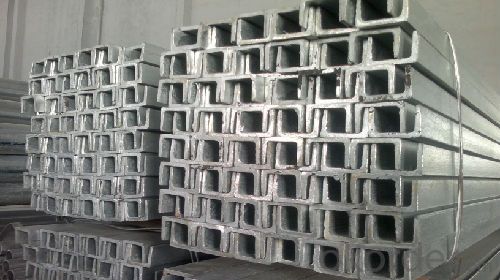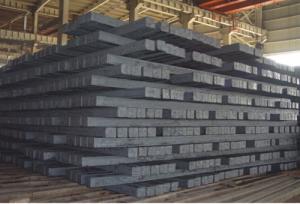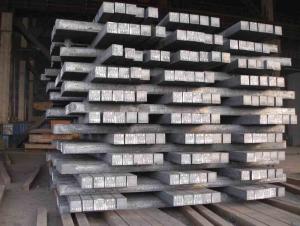JIS U Channel 50-300MM Hot Rolled EN10025JR High Quality
- Loading Port:
- Shanghai
- Payment Terms:
- TT or LC
- Min Order Qty:
- 25 m.t.
- Supply Capability:
- 20000 m.t./month
OKorder Service Pledge
OKorder Financial Service
You Might Also Like
Product Description:
OKorder is offering high quality Hot Rolled Steel I-Beams at great prices with worldwide shipping. Our supplier is a world-class manufacturer of steel, with our products utilized the world over. OKorder annually supplies products to European, North American and Asian markets. We provide quotations within 24 hours of receiving an inquiry and guarantee competitive prices.
Product Applications:
According to the needs of different structures, Angle can compose to different force support component, and also can be the connections between components. It is widely used in various building structures and engineering structures such as roof beams, bridges, transmission towers, hoisting machinery and transport machinery, ships, industrial furnaces, reaction tower, container frame and warehouse etc
Product Advantages:
OKorder's Steel I-Beams are durable, strong, and resist corrosion.
Main Product Features:
· Premium quality
· Prompt delivery & seaworthy packing (30 days after receiving deposit)
· Corrosion resistance
· Can be recycled and reused
· Mill test certification
· Professional Service
· Competitive pricing
Product Specifications:
Manufacture: Hot rolled
Grade: Q195 – 235
Certificates: ISO, SGS, BV, CIQ
Length: 6m – 12m, as per customer request
Packaging: Export packing, nude packing, bundled
Sizes: 25mm-250mm | ||||||||||||
a*t | ||||||||||||
25*2.5-4.0 | 70*6.0-9.0 | 130*9.0-15 | ||||||||||
30*2.5-6.6 | 75*6.0-9.0 | 140*10-14 | ||||||||||
36*3.0-5.0 | 80*5.0-10 | 150*10-20 | ||||||||||
38*2.3-6.0 | 90*7.0-10 | 160*10-16 | ||||||||||
40*3.0-5.0 | 100*6.0-12 | 175*12-15 | ||||||||||
45*4.0-6.0 | 110*8.0-10 | 180*12-18 | ||||||||||
50*4.0-6.0 | 120*6.0-15 | 200*14-25 | ||||||||||
60*4.0-8.0 | 125*8.0-14 | 250*25 | ||||||||||
FAQ:
Q1: Why buy Materials & Equipment from OKorder.com?
A1: All products offered byOKorder.com are carefully selected from China's most reliable manufacturing enterprises. Through its ISO certifications, OKorder.com adheres to the highest standards and a commitment to supply chain safety and customer satisfaction.
Q2: How do we guarantee the quality of our products?
A2: We have established an advanced quality management system which conducts strict quality tests at every step, from raw materials to the final product. At the same time, we provide extensive follow-up service assurances as required.
Q3: How soon can we receive the product after purchase?
A3: Within three days of placing an order, we will begin production. The specific shipping date is dependent upon international and government factors, but is typically 7 to 10 workdays.


- Q:How are steel billets used in the production of mining equipment?
- Steel billets are an essential component in the production of mining equipment due to their strength, durability, and versatility. These billets are typically made from molten steel that is poured into a mold to form a solid rectangular shape. The resulting billets are then used as raw material in the manufacturing process of mining equipment. Mining equipment, such as excavators, bulldozers, and crushers, require robust and reliable components to withstand the harsh conditions and heavy loads experienced in mining operations. Steel billets provide the necessary structural integrity and toughness to ensure the equipment can operate efficiently and safely. Once the steel billets are obtained, they are further processed through various techniques, such as forging, machining, and welding, to transform them into specific parts and components. For example, billets can be hot or cold forged to create heavy-duty gears, shafts, and axles, which are crucial for the functioning of mining equipment. Additionally, steel billets can be machined to precise dimensions and specifications, allowing the production of custom-made components that fit seamlessly into the mining equipment. This machining process involves cutting, drilling, and milling to create parts like buckets, cutting edges, and chassis. Furthermore, steel billets can undergo welding processes to join different parts together and create complex structures. Welding ensures the integrity and strength of the equipment, as it provides a secure bond between the billets and other components. This is particularly important in the construction of mining equipment, where safety and reliability are paramount. Overall, steel billets play a vital role in the production of mining equipment by providing the necessary raw material for the manufacturing process. Their strength, durability, and versatility make them ideal for creating robust and reliable components that can withstand the demanding conditions encountered in mining operations.
- Q:How are steel billets used in the manufacturing of marine components?
- Steel billets are used in the manufacturing of marine components as they serve as the starting material for forging, casting, or machining various parts like propellers, hull structures, valves, and shafts. These billets undergo further processing to form the desired shapes and sizes, ensuring the strength, durability, and corrosion resistance required for marine applications.
- Q:How are steel billets used in the production of agricultural equipment?
- Steel billets are used in the production of agricultural equipment as they serve as the raw material for manufacturing various components such as gears, shafts, brackets, and frames. These billets are melted, cast, and then forged or machined into the desired shape to create sturdy and durable parts that can withstand the harsh conditions and heavy loads encountered in agricultural operations.
- Q:How are steel billets used in the manufacturing of hydraulic cylinders?
- Steel billets are a fundamental part of hydraulic cylinder production, serving as the initial material for the manufacturing process. These billets, which are cylindrical shapes made of raw steel, are essential in various industries such as construction, mining, and automotive, as they provide linear force and motion. To create hydraulic cylinders, steel billets are heated and shaped using specialized machinery like hydraulic presses or hot rolling mills. This process, known as forging, involves subjecting the billets to immense pressure and heat to reshape them as required. Once forged, the steel billets are machined and precisely cut to form the necessary features, including the bore and mounting holes, essential for the hydraulic cylinder's functionality. This machining process ensures that the cylinder has the correct dimensions and tolerances. Following machining, the steel billets undergo heat treatment to enhance their mechanical properties. This involves heating the billets to specific temperatures and rapidly cooling them, resulting in improved strength, hardness, and resistance to wear and fatigue. After undergoing forging, machining, and heat treatment, the steel billets are ready for assembly into hydraulic cylinders. The various components like pistons, piston rods, seals, and bearings are carefully fitted together to create fully functioning hydraulic cylinders. In summary, steel billets play a vital role in the production of hydraulic cylinders. Through forging, machining, and heat treatment, these billets are transformed into components with the desired properties. The resulting hydraulic cylinders are then utilized in diverse applications, delivering efficient and reliable linear force and motion.
- Q:How do steel billets differ from steel ingots?
- Steel billets and steel ingots, both intermediate forms of steel in the steel manufacturing process, have distinct differences. To begin with, the shape and size of steel billets and steel ingots vary. Steel billets are typically square or rectangular, with a cross-sectional area of roughly 36 square inches. They are long and slim, measuring approximately 6 to 12 inches in width and 1 to 12 feet in length. Conversely, steel ingots are generally larger and possess irregular shapes. Depending on the production method employed, they can be cylindrical, rectangular, or a combination of shapes. Steel ingots tend to be much larger than billets, weighing anywhere from several tons to over 100 tons. Secondly, the production process for steel billets and steel ingots also differs. Steel billets are commonly formed through continuous casting, which involves pouring molten steel into a mold and subsequently cooling and solidifying it to shape the billet. This process ensures a more precise and uniform shape, size, and composition. In contrast, steel ingots are typically produced via ingot casting, where molten steel is poured into a sizable mold and left to solidify. This method is often utilized for larger ingots, allowing for a more adaptable and flexible production process. Lastly, the purpose and usage of steel billets and steel ingots also vary. Steel billets are frequently employed as raw materials for further processing and shaping into various steel products, such as bars, rods, wire, and tubes. They serve as the initial stage in the production of finished steel goods. Conversely, steel ingots are commonly utilized for more specialized applications, such as the production of large steel components, forgings, or specialty alloys. Their larger size and irregular shape make them suitable for demanding applications of this nature. In conclusion, steel billets and steel ingots differ in terms of their shape, size, production process, and usage. While steel billets are slender, square or rectangular, and used as raw material for further processing, steel ingots are larger, possess irregular shapes, and are often employed for specialized applications.
- Q:What is the role of steel billets in the construction of stadiums and arenas?
- Steel billets play a crucial role in the construction of stadiums and arenas. These billets, which are essentially semi-finished steel products, serve as the raw material for various structural components used in the construction process. One of the primary applications of steel billets in stadium and arena construction is for the fabrication of steel beams and columns. These structural elements provide the necessary support and stability to the overall structure. Steel billets are first heated and then passed through rolling mills to acquire the desired shape and size required for these beams and columns. Moreover, steel billets are also used in the production of steel reinforcing bars, commonly known as rebars. These rebars are used to reinforce the concrete structures within stadiums and arenas, such as foundations, walls, and floors. The combination of steel and concrete enhances the structural integrity and load-bearing capacity of these structures, making them capable of withstanding heavy loads, vibrations, and external forces. Additionally, steel billets are utilized in the construction of roof trusses and frames, which provide support for the stadium or arena's roofing system. These steel components offer the necessary strength and durability to withstand the weight of the roof, while also ensuring the overall stability of the structure. Furthermore, steel billets are employed in the production of seating structures, staircases, handrails, and other architectural elements within stadiums and arenas. These components not only contribute to the overall aesthetics of the venue but also provide safety and comfort to spectators. In summary, steel billets are indispensable in the construction of stadiums and arenas. They are transformed into various structural and architectural components that provide strength, stability, and durability to the overall structure. By utilizing steel billets, stadiums and arenas can be built to withstand the demands of large crowds, harsh weather conditions, and the test of time.
- Q:What are the main factors that determine the demand for steel billets in different industries?
- The main factors that determine the demand for steel billets in different industries are the overall economic conditions, including GDP growth and industrial production, as well as the specific needs and requirements of each industry. Other factors include the level of infrastructure development, population growth, urbanization, and construction activities. Additionally, factors such as technological advancements, environmental regulations, and government policies can also influence the demand for steel billets in different industries.
- Q:How are steel billets used in the manufacturing of shipbuilding parts?
- Steel billets play a crucial role in the manufacturing of shipbuilding parts. These billets are essentially semi-finished steel products, typically in the form of rectangular or square bars, that are used as raw material for further processing in shipbuilding. To begin with, steel billets are subjected to a process called rolling, where they are passed through a series of rollers to reduce their cross-sectional area and increase their length. This rolling process transforms the billets into long, thin sections of steel known as plates or sheets. These plates or sheets are then used to create various shipbuilding components, such as hulls, decks, bulkheads, and superstructures. After the rolling process, the steel plates or sheets are cut into desired sizes and shapes using cutting machines or torches. These cut pieces are then formed, bent, and welded together to form the required shipbuilding parts. For instance, the steel plates may be bent and welded to create curved sections for the ship's hull, or they may be formed into intricate shapes for other components. Moreover, steel billets are also used to produce forged shipbuilding parts. In this case, the billets are heated to a high temperature and then subjected to intense pressure to reshape the steel. This forging process results in stronger and more durable shipbuilding parts, which are often used for critical components like propeller shafts, crankshafts, and turbine blades. In summary, steel billets serve as the starting point in the manufacturing of shipbuilding parts. Through processes like rolling, cutting, forming, and forging, these billets are transformed into plates, sheets, and forged components that are used to construct the various structural and functional elements of ships.
- Q:What are the common heat treatment processes for steel billets?
- Steel billets can undergo several heat treatment processes to modify their mechanical properties, including hardness, strength, and toughness, to meet specific requirements for different applications. One prevalent heat treatment process for steel billets is annealing. This involves heating the steel to a specific temperature and maintaining it at that temperature for a set duration, followed by gradual cooling. Annealing helps alleviate internal stresses in the steel, improve its machinability, and enhance its ductility. Another widely used heat treatment process for steel billets is quenching and tempering. Quenching involves rapidly cooling the steel from a high temperature to room temperature using a liquid or gas medium, like water or oil. This process results in hardened steel with increased strength and hardness. However, the steel becomes brittle after quenching, so it is then tempered by reheating it to a lower temperature and holding it at that temperature for a specific time period. Tempering reduces brittleness and improves the toughness and ductility of the steel. Normalizing is another heat treatment process employed for steel billets. It entails heating the steel to a temperature above its critical transformation temperature and then cooling it in still air. Normalizing helps refine the grain structure of the steel, improve its mechanical properties, and enhance its machinability. Lastly, stress relieving is a process used to reduce internal stresses in steel billets that may have been generated during manufacturing processes such as casting or forging. Stress relieving involves heating the steel to a specific temperature and maintaining it at that temperature for a certain duration, followed by gradual cooling. This process aids in improving dimensional stability and reducing the risk of distortion or cracking in the steel. Overall, these common heat treatment processes for steel billets play a vital role in optimizing the properties and performance of steel for various industrial applications, including automotive, construction, aerospace, and energy sectors.
- Q:How do steel billets contribute to the manufacturing of construction equipment?
- The manufacturing of construction equipment heavily relies on steel billets, which are semi-finished steel products shaped and sized through casting. These billets, usually rectangular or square, serve as the initial stage for further processing. An important aspect of steel billets in construction equipment manufacturing is their provision of high-quality raw material. Steel is renowned for its exceptional strength, durability, and resistance to various environmental factors. By incorporating steel billets, manufacturers can guarantee that the construction equipment they produce can withstand the demanding conditions and heavy loads often encountered in the construction industry. Additionally, steel billets are utilized in the production of various construction equipment components, including frames, beams, brackets, and other structural elements. By utilizing steel billets, manufacturers can easily mold and shape these components to meet specific design requirements. This adaptability enables the creation of equipment that is not only robust and long-lasting but also lightweight and efficient. Moreover, the use of steel billets in construction equipment manufacturing is driven by their cost-effectiveness. Steel is a highly recyclable material, allowing for multiple reuses and repurposing without compromising its properties. This renders steel billets a sustainable and environmentally friendly choice for manufacturers. In conclusion, steel billets are an indispensable element in the manufacturing of construction equipment. They provide a high-quality raw material that possesses strength, durability, and resistance to environmental factors. Steel billets also facilitate the production of customized components that meet specific design requirements. Furthermore, their cost-effectiveness and recyclability make them a sustainable choice for manufacturers. Overall, steel billets significantly contribute to the production of construction equipment, ensuring adherence to the highest standards of quality and performance.
1. Manufacturer Overview |
|
|---|---|
| Location | |
| Year Established | |
| Annual Output Value | |
| Main Markets | |
| Company Certifications | |
2. Manufacturer Certificates |
|
|---|---|
| a) Certification Name | |
| Range | |
| Reference | |
| Validity Period | |
3. Manufacturer Capability |
|
|---|---|
| a)Trade Capacity | |
| Nearest Port | |
| Export Percentage | |
| No.of Employees in Trade Department | |
| Language Spoken: | |
| b)Factory Information | |
| Factory Size: | |
| No. of Production Lines | |
| Contract Manufacturing | |
| Product Price Range | |
Send your message to us
JIS U Channel 50-300MM Hot Rolled EN10025JR High Quality
- Loading Port:
- Shanghai
- Payment Terms:
- TT or LC
- Min Order Qty:
- 25 m.t.
- Supply Capability:
- 20000 m.t./month
OKorder Service Pledge
OKorder Financial Service
Similar products
New products
Hot products
Hot Searches
Related keywords






























